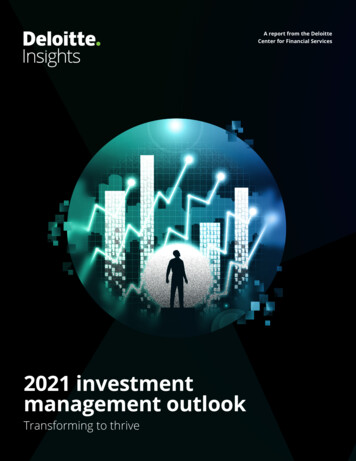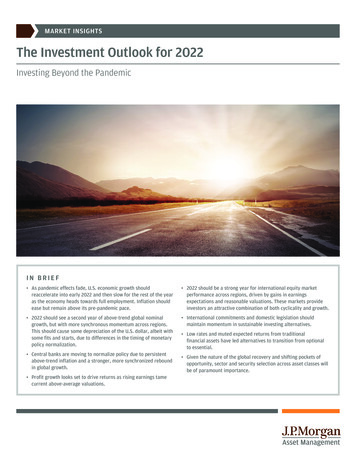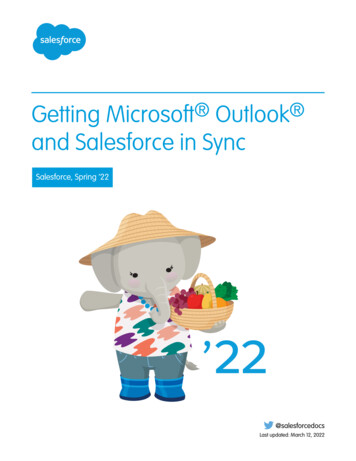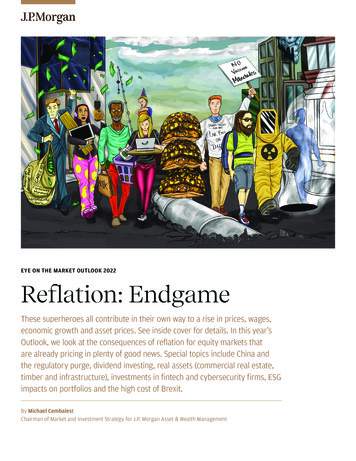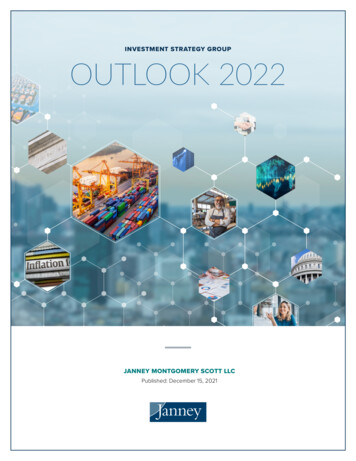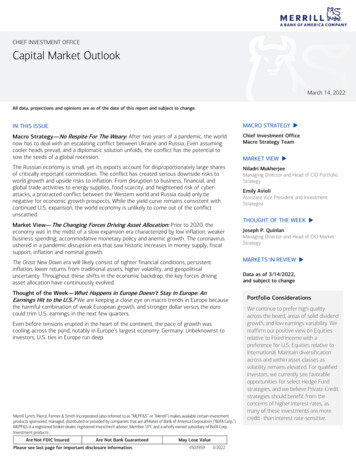
Transcription
A report from theDeloitte Center for Financial Services2022 investmentmanagement outlookPositioning for a greater impact
About the Deloitte Center for Financial ServicesThe Deloitte Center for Financial Services, which supports the organization’s US Financial Servicespractice, provides insight and research to assist senior-level decision makers within banks, capitalmarkets firms, investment managers, insurance carriers, and real estate organizations. The center isstaffed by a group of professionals with a wide array of in-depth industry experiences as well ascutting-edge research and analytical skills. Through our research, roundtables, and other forms ofengagement, we seek to be a trusted source for relevant, timely, and reliable insights. Read recentpublications and learn more about the center on Deloitte.com.ConnectTo learn more about the vision of the DCFS, its solutions, thought leadership, and events, please visitwww.deloitte.com/us/cfs.SubscribeTo receive email communications, please register at www.deloitte.com/us/cfs.EngageFollow us on Twitter at: @DeloitteFinSvcs.INVESTMENT MANAGEMENT INDUSTRY SERVICESAs global leaders in providing services to the investment management industry, Deloitte’sinvestment management practice provides global resources and capabilities with a localpresence, resulting in a clear understanding of each client’s specific market and way ofdoing business.Deloitte Investment Management services provide specialized knowledge and fresh insights intothe wide range of operational, technological, and regulatory issues surrounding the industrytoday. Regardless of whether you are in private equity, hedge funds or mutual funds, Deloitte’sinvestment management services can help you take on challenges and capitalize on businessopportunities. With the added strength of the Deloitte Touche Tohmatsu Limited (DTTL) memberfirm network, Deloitte has the ability to offer a global, integrated approach to business issuesthat combines insight and innovation from multiple disciplines to help organizations excelaround the world. To learn more, visit Deloitte.com.
ContentsThe year ahead 3The need to bring agility into talent management 6Reinvesting to change the business 12Modernizing operations responsibly 18Looking ahead 20Endnotes 21
2022 investment management outlookKEY MESSAGES Progress toward quantifiable and transparent business metrics can help firms achieve a higherbottom line, financially and socially, based on our survey conducted in the summer of 2021.Respondents that made a lot of progress quantifying the impact of DEI initiatives were morelikely to indicate that employee engagement and productivity have become much stronger sincethe start of 2021, than those who did not make a lot of progress quantifying the impact of DEI. The workplace talent model is likely to continue to shift in 2022 as employees and firms adapt tothe ever-changing requirements of operating in today’s environment. Internal communicationplans are often baked into bold talent actions to maximize benefits. Implementing goodbusiness decisions absent communication plans that are cognizant of cultural impact can lead tosuboptimal results. However, when firms pull additional levers with an eye on increasing overallemployee well-being and communicate those plans effectively, they can create opportunities fora stronger culture over the long term. An overwhelming majority (85%) of our respondents that use AI-based solutions in thepreinvestment phase either strongly agreed or agreed that AI helped them generate alpha.Using natural language processing and generation (NLP/G), a type of AI technology, analysts cansave time spent on data collection and instead focus on analyzing data with a higher potentialfor insights. Since investment management is a highly relationship-oriented business, firms that can betterengage with clients and deliver on their expectations will likely be more successful. Our surveyshows that 38% of respondents from digitally advanced firms expect significantly better revenueprospects in 2022 compared to just 13% for other, less digitally advanced firms, supporting thenotion that digital interaction is part of the relationship. There appears to be a significant regional difference in the implementation of digitaltransformation and modernization of governance mechanisms. European firms lead on theresponsible implementation front with 27% of the respondents indicating that their firms areaccelerating digital transformation as well as updating governance, followed by Asia Pacific (20%)and North America (11%). Left unchecked, inadequate governance and reporting that trailsdigital transformation could lead to significant financial, legal, and reputational repercussions.2
Positioning for a greater impactThe year aheadFINDINGS OF THE 2022 global outlook surveycontinues to test leadership to present a vision forpoint toward varied results and expectationsthe future and credible tactical steps to achieve it.for investment management firms. Thisoutlook will explore the connections betweenTo begin with, this outlook will focus on assetactions taken, the self-perceived cultural health ofgrowth and performance within the investmentinvestment management firms, and growthmanagement landscape. We will then look at otherexpectations for 2022. The survey findings aresuccess enablers such as talent models, technologyinteresting, and there’s plenty to pay attention to—and change, and vision. The varied results wefor example, responses from investmentexpect in 2022 may be driven by the ability of somemanagement industry leaders indicate afirms to create a virtuous cycle of vision,correlation between strengthening firm culture andoperational achievement, alignment withrevenue growth expectations. Talent matters andstakeholder expectations, staff resilience, andculture matters. The crucible of the pandemicstrengthening culture.ABOUT THE DELOITTE CENTER FOR FINANCIAL SERVICES 2022 GLOBAL OUTLOOK SURVEYThe Deloitte Center for Financial Services conducted a global survey among 400 senior investmentmanagement executives in finance, operations, talent, and technology.Survey respondents were asked to share their opinions on how their organizations have adapted tothe varied impacts of the pandemic on their workforce, operations, technology, and culture. We alsoasked about their investment priorities and anticipated structural changes in the year ahead, as theypivot from recovery to the future.Respondents were equally distributed among three regions—North America (the United States andCanada), Europe (the United Kingdom, France, Germany, and Switzerland), and Asia Pacific (Australia,China, and Japan).The survey included investment management companies with revenues of at least US 500 millionand was fielded in July and August 2021.3
2022 investment management outlookThe investmentmanagement landspace:Opportunities aboundyear.7 AUM growth in private capital and hedgeIn 2021, the investment management industryperformance of private capital and hedge funds infared well despite the pandemic-driven marketthe first half of 2021.8 For hedge funds, thevolatility. In the United States, while most activeUS 57.8 billion in new capital flows through theequity managers trailed the broader US equityfirst five months of 2021 speaks to the overallcomposite, more managers (43%) achieved one-positive sentiment from investors.9 Private equityeven as both saw AUM rise around 20% during thefunds is likely to continue through 2022 asinvestors indicated high levels of satisfaction in theyear alpha on an absolute returns basis in 2020funds may also see inflows increase as the numbercompared to the longer 10-year period over whichof investors planning to increase their allocations83% underperformed.1 On average, the equallyto private equity in the second half of 2021 rose toweighted performance of US active equity funds43% from 34% in the first half of 2021.10 Overall,outperformed the broad benchmark by 0.6%,investor sentiment remains positive andoutperforming for the first time since 2013.2 Whenalternative investments may be well-positioned forconsidering the all-funds comparison, US activegrowth across asset types.equity managers may be well-positioned to start atrend for a second consecutive year, as these fundsFor traditional investment managers, there areoutperformed by almost 5% for the one-year periodvarious regional opportunities for asset growth.that ended on June 30, 2021. However, whenPension funds in China are in the process ofdifferent style segments and risk-adjusted returnsoutsourcing assets to external investment3are taken into consideration, the path tomanagers. The outsourced portion of pensionresurgence for active managers becomesassets may grow to as much as RMB 6 trillionmore complicated.4( US 1 trillion) over the next several years.11 Giventhis, we expect more investment managementActive managers’ success varies significantlybetween global regions. Equity activemanagers in Euro area, the United Kingdom,and Japan enjoyed outperformance relativeto their regional benchmarks over the oneyear period ended 2020 (4.2%, 8.0% and2.9%, respectively).5 Portfolio managers inAustralia, however, have some catching up todo as the average equity fund trailed thefirms to explore opportunities in China.In 2021, the investmentmanagement industry faredwell despite the pandemicdriven market volatility.broad Australian market index by 0.2%.6 PerhapsCryptocurrency is another potential area forthe volatility and uncertainty around the directiongrowth for investment management firms.of global financial markets is helping to turn theCryptocurrencies number in the thousands, eachperformance tide in favor of active managers. Timeintroduced with a different purpose and differentwill tell.valuation drivers. Investment management firmshave the opportunity to create novel products byIn the global alternative investment managementbundling these currencies into funds with differentspace, private capital (private equity, private credit,risk and return characteristics. Some investmentinfrastructure, and real estate) continued itsmanagement firms have already launched productsrelative outperformance to hedge funds, returningrelated to these digital assets. Europe is leading the15.5% in 2020 compared to 11.1% for hedge funds,space hosting eight of the top 10 best performing4
Positioning for a greater impactexchange-traded products (ETP) that trackto align their investment strategies with advancedcryptocurrencies. More passive and manageddigital operations. As a result, continued increasesdigital asset products could be launched globally inin M&A activity are expected within the investment2022 as both client demand increases andmanagement space in 2022.12regulatory clarity are expected.As firms are positioning differently to achieve alpha,For the firms that are not achieving alpha, digitalthe outlook for 2022 is likely to be driven by thetransformation is one path that can help create aquest to have the investment strategies supportedcredible story about their brand promise toby highly advanced digital capabilities. Firms cangenerate alpha, which may be a prerequisite totake many approaches to achieve these capabilities,AUM growth. However, digital transformation canbut typically first and foremost is developing andbe difficult to achieve. More and more firms aremaintaining a talent pool that can executechoosing the mergers and acquisition (M&A) pathstrategies to achieve their vision.5
2022 investment management outlookThe need to bring agilityinto talent managementTODAY, MUCH OF the discussion of what theWhen asked to report on their firm’s culture sincefuture of the workplace may look like isthe onset of the pandemic, 38% of thesecentered around some sort of a “hybrid”respondents reported that their firm’s culture hasworkforce model in which some employees arebecome much stronger compared to only 25% whoon-site, some work remotely, while others mayindicated that their firms are likely to adopt a morework from anywhere depending on their needs andcomplicated hybrid model for the long-term. Theschedule.13 While the return to the workplacedeclared long-term intentions of the firms at thestrategy remains under development, it isends of the spectrum are likely contributing toaccompanied by several other important talent-respondents indicating that their firms arecentric success initiatives to meet strategic goalsemerging much more culturally stronger. A groupwhile enhancing corporate culture. These includeof investment management firms, includingredefining the communication strategy for talent,Goldman Sachs Asset Management, have well-quantifiably addressing the firm’s vision andarticulated positions that investment managementpurpose, upskilling existing talent to meetis best carried out over the long-term with anchanging requirements, staff resilience, and theapprenticeship model that requires employees toutilization of mergers, acquisitions, andbe present in the office.14outsourcing. Let’s explore each one of themin detail.Return to the workplaceEvery investment management firm faces thereturn to the workplace transition. Most firmscurrently have hybrid approaches in place.However, only a few firms have declared andimplemented long-term strategies at either end ofthe spectrum of opportunities—majority back asAlmost three-fourths of thesurvey respondents indicatedtheir firm is likely to adopteither a majority back assoon as possible or a highlyflexible on return to theworkplace strategy.soon as possible and highly flexible on return tothe workplace. There are interesting culturalThe firms in the middle may be suffering from adynamics at play in these approaches that firmsspecter of uncertainty haunting employees. Onlymay consider as they formulate their long-term25% of respondents at these firms with wait-and-strategy. Almost three-fourths of the surveysee or hybrid workforce model approachesrespondents indicated their firm is likely to adoptindicated that their firm is emerging with a mucheither a majority back as soon as possible or astronger culture since the start of the pandemic.highly flexible on return to the workplace strategy.The communication level needed to help6
Positioning for a greater impactFIGURE 1employees understand a complex and stillThere is a gap in alignment of purposeand vision between respondents fromtalent and other functionschanging end-state is likely much harder to achieve.Developing and communicating these vitalreturn-to-the-workplace plans optimallyis tricky and impactful—especially for theStrongly agreeor agreefirms that choose a hybrid end-state.62%Communication strategyFrom the uncertainty related to the return to theDid notagree orneutralworkplace to the increased demand for social38%My institution'sworkforce isaligned with oursense of purpose(talent)justice, leaders at many investment managementfirms have had ample reasons to reexamine theirMuchimprovedfirm’s vision and purpose. As they reconsider theirfirm’s mission statements, there’s also an36%opportunity to rethink how they will communicateUnderstanding ofyour institution’svision (IT,operations,and finance)this renewed sense of purpose with their employeesto ensure they feel empowered and aligned with it.However, many investment management firmsmay find this challenging due to the existing gap inalignment between functional organizations withinDid notimprove muchthe firm about purpose. According to our survey,64%62% of talent professionals strongly agree or agreeSource: The Deloitte Center for Financial Services GlobalOutlook Survey 2021.that their firm’s workforce is aligned with theirinstitution’s sense of purpose. This number is notDeloitte Insights deloitte.com/insightsimproving dramatically. Only 36% of respondentsoutside of talent (IT, operations, and finance)purpose.15 By giving their employees a voice, abelieve that their understanding of theircollaborative relationship with workers that isinstitution’s vision has improved since the start ofsustainable and possibly even a differentiator may2021, as shown in figure 1.take hold.16 This approach should be consideredregardless of the long-term workplace strategy, asThis gap in employees’ alignment with theironly 37% of all respondents indicated theirorganizational purpose may exist due tounderstanding of their firm’s vision was muchuncertainty among employees outside of the talentstronger since the beginning of 2021. It’s importantfunction regarding their personal contribution toto note that successfully engaging with employees inthe firm’s vision. To remove this uncertainty, firmscocreating the firm’s purpose goes beyond takingmay rethink their vision and allow all theiremployees’ input; it includes giving them influenceemployees to become cocreators of the firm’sinto how best to achieve that purpose.177
2022 investment management outlookTransparent quantifiablemetricsAvoiding potential negative implications ofdiversity-washing is one part of the solution. Tomake sure they make meaningful progress onInvestment management firms today have theachieving their goals, firms should first quantifyopportunity to reimagine the role they play inthe impact that their efforts are making. Our recentsociety taking into consideration a broader range ofsurvey results show that DEI reporting is related tostakeholders such as employees, customers,employee engagement and productivity.regulators, and shareholders. Key focus areas inRespondents who made a lot of progressthis regard are trust and confidence. As a first stepquantifying the impact of DEI initiatives in theirto boost trust and confidence, the investmentfinancial statements were more likely to indicatemanagement industry can look to confrontthat employee engagement and productivity havegreenwashing. Greenwashing is one of the biggestbecome much stronger (39%) since the start ofchallenges in making sustainability decisions as2021, than those who did not (19%) make a lot ofsome sustainability initiatives are plagued with aprogress quantifying the impact of DEI.lack of transparency.18 A similar issue that manyProductivity appears linked to achieving aspects ofinvestment management firms face as they work tothe firm’s vision. Respondents also indicated thataddress a lack of diversity in senior levels iscollaboration and teamwork became muchdiversity-washing. Disclosing progress usingstronger for firms that made a lot of progressquantifiable metrics may help prevent accusationsquantifying DEI initiatives than firms that didn’tof both greenwashing and diversity-washing.19(38% vs. 28%). Progress toward quantifiable andThrough these types of disclosures, investmenttransparent business metrics can help firmsmanagement firms may contribute to theachieve a higher bottom line, financiallyrebuilding of the public’s trust in institutions as theand socially.future of financial services moves toward a higherbottom line for the benefit of all of society’sstakeholders.In addition to increasing the focus on DEI, manyfirms are implementing broader ESG initiatives.20However, few firms are reporting the impact ofWhen a firm delivers a message around socialthese initiatives in a robust way. In most casesissues, being genuine may be more crucial to gainfirms are increasing their focus on ESG initiativesits workforce’s support as opposed to trying tobut are failing to realize the full benefit ofmake the boldest statement.21 Being able todifferentiation. This gap between implementationdemonstrate the firm’s progress toward achieving aand communication demonstrates the importancegoal is a key component of avoiding potentialof reporting quantifiable metrics to all stakeholders.diversity-washing claims from stakeholders. ForFirms that do not adequately report the impact ofexample, our survey indicates that manyESG initiatives may be perceived by customers andinvestment management firms have made someregulators as performing greenwashing.22strides in their diversity, equity, and inclusionGreenwashing has led to increased risk of losing(DEI) efforts. The percentage of respondents whoclients, regulatory scrutiny, and deterioratingstrongly agree or agree that their firm is focusingaccess to financing.23on increasing the level of diversity in hiring,development, and leadership increased to 60%Intelligent employee upskillingfrom 43% in the prior year. One possibleexplanation for such a meaningful increase maybe that these firms reported their progress onIn 2022, investment management firms have anDEI initiatives.opportunity to use training and development to8
Positioning for a greater impacthelp their talent stay abreast of developments in 52% more likely to indicate that their firm hasproducts, asset classes, processes, and technologies.developed a much stronger culture at theirInvesting in employees’ relevant training needs canorganization since the onset of the pandemic.help reap benefits in multiple ways. Doing it wellby tailoring opportunities for upskilling to eachTraining programs at investment managementemployee’s personal goals can improvefirms will likely see increased emphasis in 2022,collaboration and employee well-being and create aand the most successful programs are likely tostronger culture. While 65% of respondentsenable employees to drive their training curricula.working in senior talent roles strongly agree oragree that their firm is educating and trainingStaff resiliencetalent on relevant skill sets, only 35% ofrespondents from other functions believe theirfirm’s emphasis on learning has been muchEmployee productivity, well-being, improved riskstronger since the pandemic. A possible solutionappetite, empowered decision-making, and teamfor narrowing this gap is to use a personalizedcollaboration are elements of culture that togetherupskilling approach aligned with each employee’srepresent staff resilience. Staff resilience risk isgoals. Rather than allocating the trainings availablemitigated when firm cultures are strengthened.to employees, firms can flip the script by setting upRespondents who reported that their firms’ overallan opportunity marketplace allowing employees toculture became much stronger since the beginningtake control of their career path. This change mayof 2021 were:24in turn improve employee retention.25 Asemployees begin to feel their firm’s training 61% more likely to indicate that they haveopportunities align with their own, the firm maygotten much stronger in terms of empoweredexperience positive impacts elsewhere. Fordecision-makingexample, the respondents who reported a muchstronger emphasis on learning at their firms were: 58% more likely to say their risk appetite hasbecome much strongerRespondents indicatedthat collaboration andteamwork became muchstronger for firms thatmade a lot of progressquantifying DEI initiativesthan firms that didn’t. 37% more likely to report much strongeremployee engagement and productivity 27% more likely to state collaboration hasgotten much stronger across teams 25% more likely to report much strongeremployee well-beingIn fact, only 20% of respondents in firms that haveemerged much stronger culturally ranked staffresilience risk among the top two operational risks, 28% more likely to say collaboration has gottencompared to 40% at firms with lesser culturalmuch stronger across teamsstrength ranks. 34% more likely to report much strongerFirms are taking specific strategic actions aimed atemployee well-beingbuilding a strong company culture and mitigating9
2022 investment management outlookstaff resilience risk. The Carlyle Group has takenincrease broadly with concentration in investmentsuch a step by linking its chief executive officer’smanagement firms with between US 5 billion andcompensation to developing an inclusive culture atUS 10 billion in annual revenue over the course ofthe firm.26 Moreover, the company has also set2022. This finding aligns with expectations foraside US 2 million to recognize employees thathave gone above and beyond to meet DEI goals.continued consolidation among smaller and midsized investment management firms to gain more27DEI initiatives can help to build better culture andcapabilities to better serve clients.30improve profitability and productivity.28 Whilemany firms have programs addressing DEI, LegalInterestingly, our survey shows that adding new& General Investment Management (LGIM)technology capabilities is the top driver forrepresents one success story. LGIM attributes theirrespondents’ M&A transactions, followed byability to achieve gender parity in senior leadershipincreasing scale and distribution channelto being flexible, adaptable, and constantlyexpansion. These firms are looking to fuel growthreceptive to employees’ views.29 These culturethrough enhanced products and customerstrengthening actions can impact employeeexperience delivered to an expanded client (andresilience at an important time, when good talentprospect) base. M&As are expected to accelerate inis hard to replace, and openings can2022 as many firms can still potentially benefitstrain productivity.from them.Rather than allocatingthe trainings available toemployees, firms can flipthe script by setting up anopportunity marketplaceallowing employees to takecontrol of their career path.The workplace talent model is likely to continue toshift in 2022 as employees and firms adapt to theever-changing requirements of operating in today’senvironment. Internal communication plans areoften baked into bold talent actions to maximizethe benefits. Implementing good businessdecisions absent communication plans that arecognizant of cultural impact can lead to suboptimalresults. However, when firms pull additional leverswith an eye on increasing overall employee wellbeing and communicate those plans effectively, itcan create opportunities for a stronger culture overthe long-term.The number of deals in the investmentmanagement space has increased from 516 in 2016to 628 in 2020.31 Furthermore, the number of dealsMergers, acquisitions,and outsourcingannounced through Q3 for 2021, 2020, and 2019are 548, 457, and 484, respectively, showing aspike in 2021.32 The deal value has increased toAs firms manage their cost, capability, and scaleUS 31.6 billion for the first three quarters of 2021equations, mergers, acquisitions, and outsourcingcompared to US 26.3 billion and US 22.2 billioncontinue to be in the solution set. Survey findingsduring the same period in 2020 and 2019,indicate that global M&A activity is expected torespectively.3310
Positioning for a greater impactOutsourcing has recently garnered attention fromfrequently suggested hiring more risk andFINRA for its impact on extended enterprise risk.compliance management talent. Investment34In addition to the regulatory and riskmanagement firms that neglect to include the needconsiderations, investment management firms mayfor enhanced governance and control as costs inbenefit from conducting a more holistic review oftheir outsourcing decision-making process maythe potential effects that outsourcing may have onoverstate the benefits to the firm and itsits workforce. When a strategic decision is made tostakeholders. To effectively minimize disruption tooutsource a function, the firm may also want tothe firm’s culture, employee engagement, andtake steps to ensure that cross-functional processesemployee well-being, firms can communicate theremain unaffected. Respondents in talent rolesstrategic nature of the transaction and the benefitswho indicated that increased outsourcing couldto both the affected employees and to the firm.most effectively improve their institution lessWhen making a strategic decision to outsource a function,firms should take steps to ensure that cross-functionalprocesses remain unaffected.11
2022 investment management outlookReinvesting to changethe businessINVESTMENT MANAGERS ARE increasinglyinvesting in transforming their operations. Firmsare using cost savings driven by pandemic-related pressures and a positive economicenvironment to invest in cloud and outsourcedservices more frequently than replacing proprietaryand on-premise technology. Though most firms aredigitally transforming their businesses, they havemade progress to varying degrees. One factor thatsets apart firms in their digitization journey is theiragility in execution. Only about half (49%) of oursurvey respondents reported that their institution’sagility in execution has emerged much strongersince the beginning of 2021. Demonstrating theimportance of agility to digital transformation, avast majority (85%) of these “much stronger”respondents ranked their organization 8 or higheron a 10-point scale when asked to indicate howclose their firm is to the ideal digital organization,compared to just over half (51%) of all otherrespondents. That said, firms of all stripes areexpected to continue their digitization efforts in thenext year. Survey responses indicate that the mostimportant drivers for digitization includeimproving operational efficiency (45%) andcreating opportunities that did not exist or werenot viable previously (42%). Let us dive deeper intoeach of the drivers.sourcing and improving portfolio companyoperations is a focus area as deal valuations rise.35Improving operationalefficiencyFirms are increasingly turning to digitalization foroperational improvements. As seen in figure 2,respondents from all geographies are expecting aOperational efficiency is increasingly important forbigger increase in net spending across emergingtraditional investment managers as the rise of low-technologies compared to last year. This trend iscost passive investing increases competitivelikely supported by higher revenues and expandedpressures. For private equity firms, efficient dealmargins that firms have enjoyed through the first12
Positioning for a greater impactFIGURE 2Firms su
management outlook Positioning for a greater impact A report from the . save time spent on data collection and instead focus on analyzing data with a higher potential for insights. Since investment management is a hig
